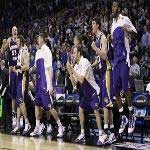
STEVE EMBER:
Welcome to THIS IS AMERICA in VOA Special English. I'm Steve Ember.
FAITH LAPIDUS:
And I'm Faith Lapidus. This week on our program, we tell about the largest college sports organization in the United States. The National Collegiate Athletic Association includes colleges and universities, athletic conferences and non-profit organizations. It has over 1,000 members. The NCAA sets rules for student athletes and their schools.
It links academic studies, sports, rules and big business. But most Americans think about one thing when they hear NCAA: championships.
(SOUND)
STEVE EMBER:
This month, many Americans are caught up in the yearly tradition of "March Madness." It describes the excitement over the Men's and Women's NCAA National Basketball Championships. The first games began March 16th. People join "office pools" in work places around the country — usually to bet on the men's championship.
Fans in office pools try to predict the winners of each of the 63 games and the college basketball champion. They fill out forms called brackets with their choices of which team they think will win. Usually, people bet five or ten dollars. Quang Lam, a Web producer from Virginia, says he is in three pools this year: two for money and one for fun. First prize in one pool is 1,000 dollars. Fans used to fill in their brackets on paper. Today, office pools are mostly done on-line. People bet tens of millions of dollars on NCAA tournament games in Las Vegas, Nevada, where gambling is legal. But Americans bet much more in office pools nationwide.
FAITH LAPIDUS:
Everyone in office pools wants to pick the Final Four. Those are the last four winning teams remaining from a field of 65 in the men's competition. This year's NCAA Men's Final Four competition takes place in Indianapolis, Indiana starting April 3rd. The top women's teams play in San Antonio, Texas beginning April 4th.
There are always surprises during March Madness. This year's top men's team, the University of Kansas, lost in the second round to ninth seeded Northern Iowa University. But evenly matched teams often play to exciting finishes like Michigan State University's last second victory over the University of Maryland.
(SOUND)
STEVE EMBER:
In some ways, the NCAA really is about championships. The first was held in 1921. Sixty-two teams competed in the National Collegiate Track and Field Championship held at the University of Chicago. Today, the NCAA holds 88 championships in 23 sports every year. Since 1973, colleges and universities have competed in three divisions. The largest schools compete in Division One.
FAITH LAPIDUS:
This year, the NCAA is marking its 104th year. But it is only the 29th year that women's championships have been part of NCAA sports.
Before the early 1970s, women did compete in sports clubs at America's colleges and universities. But these activities were not organized as they are now. Women's competitions were organized through health associations or other groups. And they received little attention compared to men's sports.
But in 1972, Congress passed the federal law known as Title Nine. It bars discrimination based on sex at educational institutions that receive federal money. Title Nine changed college sports forever. Joni Comstock is a top official for championships with the NCAA.
JONI COMSTOCK: "Women's programs began to ramp up and get more support and resources and attention post 1972. And by 1981 men's and women's programs were joined together under the umbrella of the NCAA."
STEVE EMBER: More than 400,000 students take part in sports organized by the NCAA. Women and men still do not take part in athletics in equal numbers. But Joni Comstock says NCAA women's participation has grown a lot.
JONI COMSTOCK: "In 1981, we had approximately 64,000 women who are participating in NCAA intercollegiate athletics across this country. And today we have approximately 177,000 female participants in our NCAA institutions."
College teams may have both men and women in three sports: skiing, rifle shooting and fencing. Only in rifle do women compete directly against men. This year's champion was Texas Christian University. In rifle, women competitors are so strong that TCU became the first all-female team to win the NCAA championship.
As senior vice-president for championships, Joni Comstock knows how hard it is to coordinate big sports events. She says the NCAA spends about 70 million dollars a year to organize championships. Fifty-seven thousand student-athletes take part. Joni Comstock says championships are held in rounds at different places around the country.
JONI COMSTOCK: "If you take the 88 championships and then you count each of the rounds within those championships and then all of the sites, we run on an annual base of 756 different events all over the country."
The NCAA has more than 380 professional employees working mainly at its headquarters in Indianapolis, Indiana.
(MUSIC)
FAITH LAPIDUS:

The Men's and Women's Final Four basketball championship receives a lot of attention at NCAA headquarters. But they are not even the last of the winter season championships. The division one hockey championship, called the Men's Frozen Four, finishes on April 10th.
Still, it is hard to overstate the importance of the men's and women's division one basketball championships to the NCAA. The University of Oregon won the first men's tournament in 1939. That event was held at Northwestern University near Chicago. It lost money.
Today, money is not a problem. The NCAA has a contract with CBS Television to broadcast the men's tournament. It is worth about 617 million dollars this year. A contract with ESPN is worth 73 million dollars over the next four years. It includes broadcasting rights for the women's championship games.
Television and marketing money from these events make up about 85 percent of the NCAA's income. Much of that, however, is returned to the colleges and universities. Sixty percent of the NCAA's expenses are payments to its division one schools.
STEVE EMBER:
People have criticized the NCAA for placing too much importance on the business side of college sports. Education Secretary Arne Duncan recently urged banning teams with low graduation rates from play in the NCAA basketball tournament. Some men's basketball teams have graduation rates well below 40 percent. But the NCAA says that graduation rates among all student athletes are higher than the general student population.
Joni Comstock says the NCAA does a lot of research on the effect of sports on student-athletes. She says 90 percent of student-athletes say they believe they have developed strong skills of leadership and teamwork. And over 90 percent of college athletes say their experience has helped them in their current jobs.
(MUSIC)
FAITH LAPIDUS:
The roots of the NCAA date back to the need to control one sport—American football. In fact, a former NCAA worker Kay Hawes wrote that the NCAA's "father was football and its mother was higher education." In the early 1900s, football was wildly popular. The sport had fewer rules, was extremely violent and provided little protection for players. Serious injuries and deaths were common.
In 1905, President Theodore Roosevelt called together representatives from Harvard, Princeton and Yale universities. His idea was to change the rules of football to make it safer. The message was that the game must be reformed or it would be banned.
Sixty-four colleges and universities gathered to create a new rule-making group that year. It was called the Intercollegiate Athletic Association of the United States. In 1909, it renamed itself the National Collegiate Athletic Association. But the NCAA does not hold a football championship for the biggest universities, although it does for division two and three schools. The Bowl Championship Series is managed by officials of major athletic conferences, bowl game representatives and a few schools. It is not linked to the NCAA and divides its own income of 148 million dollars separately.
STEVE EMBER:
In over a century, the NCAA has struggled with the same issues that it faces today. They are questions of sportsmanship, pay for players and influence from sports agents. Academic requirements and rules limiting the time students spend on sports are also subjects for reform and debate.
But the NCAA has built a tradition of sports competition. It has taught hundreds of thousands of talented young people about teamwork and leadership. Sports and teaching have a long history together.
(SOUND-THEME)
FAITH LAPIDUS:
Our program was written and produced by Mario Ritter. I'm Faith Lapidus.
STEVE EMBER:
And I'm Steve Ember. Join us again next week for THIS IS AMERICA in VOA Special English.
Songs about spring can be happy or sad
Just who was 'the unsinkable Molly Brown'?
Valentine's Day offers a chance to 'refocus on what love is all about'
Seeking 'cultural equity' in musical traditions
(来源:VOA 编辑:陈丹妮)
